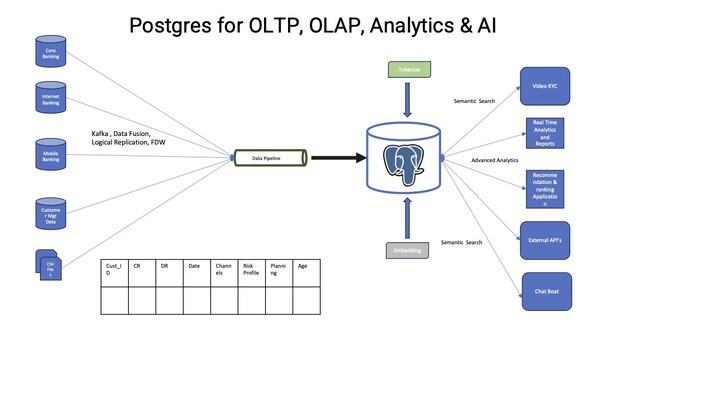In today's rapidly evolving digital landscape, organisations are grappling with the complex challenge of breaking down data silos to harness the full potential of their data assets. Real-time analytics and AI workloads are at the forefront of this transformation, driving the need for robust, scalable, and versatile database solutions. With its advanced capabilities and innovative pgvector extension, PostgreSQL is emerging as a choice of database for organisations aiming to solve these critical challenges.
The Quest for Real-Time Analytics
As businesses strive to stay ahead in a competitive market, the ability to analyse data in real-time has become a key differentiator. Real-time analytics empower organisations to make informed decisions swiftly, respond to customer needs with agility, and identify opportunities and threats as they happen. You can take some examples of fraud analysis in financial services systems, recommendation engines in customer-facing applications, etc. However, the journey towards achieving seamless real-time analytics is fraught with hurdles, primarily due to the fragmented nature of data across various systems and platforms.
Enter PostgreSQL is a database renowned for its reliability, robustness, and rich feature set that caters to complex analytical needs, with support for advanced indexing, partitioning, query optimisation techniques, and seamless data integration with new-age tools like Kafka, FDW, logical replication, etc. PostgreSQL provides a solid foundation for building real-time analytical platforms. Features like Common Table Expressions (CTEs) and Window Functions allow analysts and developers to craft complex queries that efficiently process large volumes of data, deriving actionable insights in real-time. Below is a high-level data integration architecture many organisations have already adopted with PostgreSQL. I also explored advanced analytical functions and queries, which you can use with PostgreSQL in my GitHub repo.

Embracing AI Workloads with pgvector
Integrating AI and machine learning into business processes represents a monumental shift in how organisations approach problem-solving and innovation. AI workloads, especially those involving embedding data for semantic search and customer profiling, require a database that efficiently handles vector data. PostgreSQL, enhanced with the pgvector extension, shines brightly in this area.
pgvector introduces vector data types and functions to PostgreSQL, enabling it to store and query vector data efficiently. This capability is crucial for implementing machine learning models directly within the database, facilitating seamless AI workloads. Organisations can leverage pgvector to perform similarity searches, rank customer preferences, and drive personalised recommendations, all within the familiar PostgreSQL environment.
Moreover, PostgreSQL's versatility extends to its language support, making it an ideal choice for data scientists and AI practitioners who work with a variety of programming languages, including Python, RUST and R. This flexibility ensures that AI models, regardless of the language they're written in, can be easily integrated and executed within the PostgreSQL ecosystem. Data scientists and AI/ML programmer can quickly build their ML/LLM model with PostgreSQL’s advanced features and functionality as a Database store.
I have explored some use cases using pgvector and embedding them with the Principal component analysis model in my GitHub.
A Unified Solution for Today's Data Challenges
The combination of PostgreSQL and pgvector offers a compelling solution to the dual challenges of real-time analytics and AI workloads. By leveraging PostgreSQL's advanced analytical features and pgvector's vector data capabilities, organisations can overcome the limitations posed by data silos, enabling a unified, data-driven approach to decision-making.
As we look towards the future, the importance of real-time analytics and AI in driving business success cannot be overstated. With its continuous innovation and community-driven enhancements like pgvector, PostgreSQL stands ready to support organisations in their journey towards a more integrated, intelligent, and responsive data landscape.
So, in short, PostgreSQL is a winning combination for your ACID compliance application workload, which you mainly use/using, your Real-Time analytics workload, including DW and the OLAP system, and your AI workload with pgvector and other features.



